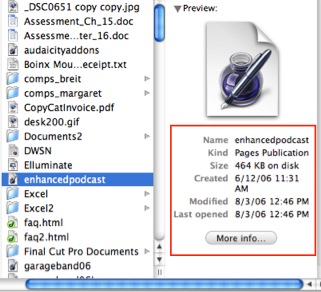How Do I Search My Mac For A File On A Specific Modified Date?
Using datemodified: in Windows File Explorer in Windows Vista, Windows 7, and Windows 8 allows you to find any files that have been modified by a date of your choice.
To search a range of dates, you have a few options: • Click a date and drag your mouse to select the range. This is the easiest option if your range falls within a month. • Click one date and then Shift-click another date. This makes it easier to select a range that spans multiple months. • Click the name of the month at the top of the calendar to select the whole month.
Updated: by Computer Hope Using the date modified feature in Windows File Explorer allows you to find any files that have been modified on a specific date or over a range of dates. Using this tip can be helpful for anyone who had lost a file, but knows when they last modified it. How to find the date of modified files • Press the +E on the keyboard to open. • On the left side scrolling menu, select the drive or folder in which you'd like to view dates ( 1).
View Time Stamps in File Explorer You can easily view time stamp information for items in File Explorer. To view details for a single file, right-click that file and choose “Properties” from the context menu.
Firefox for mac tips and tricks site. The next is the bugs and performance issues in Firefox because of huge memory consumption. It’s the same reason why I switched to chrome over Firefox. However by tweaking the Firefox settings, I was able to improve the performance in a major way. In this article, we will discuss troubleshooting steps for tweaking Firefox. Firefox Page Info window The Firefox 'Page Info' window gives you details about the page you're on. You can also use it to change permissions for the website. How to search IMDB, Wikipedia and more from the address bar Learn how to use Smart Keywords to search a specific website directly from the Firefox Location bar.
If you only know part of the name of a file or folder you are searching for, you can use wild cards such as “*” or “?”. The asterisk can replace a whole group of letters or numbers, while the question mark only replaces one character. For example, typing “books.*” in the search box will find files such as books.doc and books.pdf. Typing in book*.pdf may find files such as books.pdf as well as bookkeeping.pdf. Typing in book?pdf will only find books.pdf, but not bookkeeping.pdf. That’s because the question mark can only replace one character in the file name.
In OS X, Spotlight is an effective way to search your entire hard drive for a file or folder, email, or any other file. There are many other things Spotlight can do, and searching for files is just one of them.
To search for files on your computer using Windows XP’s search feature, select Start, Search. In the window that opens up, you will see the search assistant on the left, and the results window on the right.

You can easily sort the list by Date Modified, Date Created and even Date Accessed but do take note that sorting the list the first time will take a bit of time. Since Everything will index every file and folder found on the computer, it has some very useful filters where a few pre-made filters have been created by default to list files from different category such as audio, compressed, document, executable, folder, picture and video. So if you’re checking for possible malware infection, selecting the Executable filter will greatly help in pruning through the list. SearchMyFiles NirSoft has an excellent free search tool called SearchMyFiles where you can find very flexible and powerful search options like file/folder exclusion, files/subfolders wildcard, file size, attributes, file created, modified and accessed time.
Here is an example of what the line should look like: touch –mt 15 /Volumes/Mac HD/Pictures/Album 15 in the example above represents 8 th June 2010 10:15 AM. • Add /* to the end of the command. If you’re only targeting a specific file type include its extension (e.g.
On GNU-compatible systems (i.e. Linux): find. -mtime 0 -printf '%T+ t%s t%p n' 2>/dev/null sort -r more This will list files and directories that have been modified in the last 24 hours ( -mtime 0). It will list them with the last modified time in a format that is both sortable and human-readable (%T+), followed by the file size (%s), followed by the full filename (%p), each separated by tabs ( t). 2> Free video converter for mac softonic. /dev/null throws away any stderr output, so that error messages don't muddy the waters; sort -r sorts the results by most recently modified first; and more lists one page of results at a time.
Replace YYYYMMDDhhmm with the desired date information: touch –mt YYYYMMDDhhmm • Open a Finder window and locate the file you wish to modify. Drag and drop the file into the Terminal window, the file and path will be added to the end of the line you just typed. Here is an example of what the line should look like: touch –mt 25 /Volumes/Mac HD/Pictures/myfile.jpg 25 in the example above represents 30 th June 2010 3:25 PM.